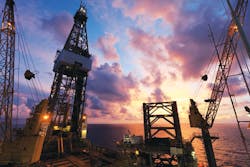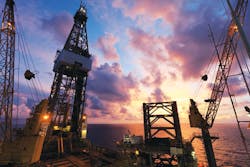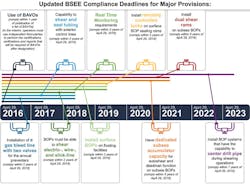Prescriptive, challenging to implement, expensive
Christopher Scheefer
Capgemini North America
The Bureau of Safety and Environmental Enforcement (BSEE) published itsfinal drilling safety rule earlier this year to address a range of systems and equipment related to well control operations. The rule is designed to improve the reliability of offshore equipment and systems and to reduce the potential for another event like theDeepwater Horizon.
However, the new offshore drilling regulations designed to improve the reliability of equipment may bring more downtime, increased costs, and significantly more operator requirements for training and inspections. Industry experts also predict a potential loss of up to 190,000 jobs as a result of decreases in exploration and production.
While the BSEE said it has incorporated more than 176 public comments and suggestions from the proposed rule into the final rule, and the full set of regulations will be phased in over a few years, many industry experts feel it is still too prescriptive and challenging to implement - not to mention too expensive - especially for an industry mired in the worst economic downturn in decades.
Can the industry implement the new rule by the deadline and will the regulations have the desired effect? In reviewing the more than 500 pages of regulations, here are seven key takeaways about the final rule.
Increased BOP requirements
The new rule establishes minimum requirements for the design, manufacture, configuration, testing, inspecting, maintenance, and repair of blowout preventers (BOPs) and related equipment. From the BSEE perspective, the rule incorporates the latest American Petroleum Institute standards in establishing new minimum baseline requirements to improve the reliability and performance of this equipment.
Wells will now be required to use dual shear rams in deepwater BOPs as well as for surface BOPs on floating facilities, consistent with the industry standard API 53. According to BSEE, the double shear rams will add redundancy and increase the likelihood that a drill pipe can be sheared and sealed in an emergency. In what some insiders consider an unnecessary financial burden, the BOP stack will be required to include a mechanism that ensures the drill pipe is centered during shearing operations.
This new and potentially costly addition stems from the belief that theDeepwater Horizon’s drill pipe was not centered during shearing, and that the positioning of the drill pipe contributed to the BOP stack’s failure to properly shear the drill pipe and cap the well. Operators will have until April 2019 to comply.
Effective immediately are stricter controls over the maintenance and repair of BOPs. Under the new rule, operators are required to validate performance testing and maintenance records with a BSEE-approved verification organization. The personnel charged with inspecting, maintaining, or repairing BOP-related equipment must also meet new training standards. All this documentation, including repair and maintenance records, documentation of equipment service life, and an assessment of the state of the overall BOP system must be produced in an annual report, made available upon request.
In addition to the annual report, a complete breakdown and detailed physical inspection of the BOP will be required every five years. After concerns were raised about the significant downtime required, the final rule allows for a more flexible phased approach with staggered inspections for each component, as long as proper documentation is provided to verify the full system inspection requirement has been met over the five-year period.
The BOP pressure-testing interval has now been standardized to every 14 days, making the testing frequency on BOPs used for work-over and decommissioning the same as for drilling and completion. The BSEE believes this will result in less downtime during operations and will reduce wear and tear on critical safety equipment. However, it has left the door open for a future review to increase or decrease the testing interval. The bureau has also made it possible for operators who believe their special circumstances warrant a longer pressure test interval to request approval from the BSEE district manager to use alternate procedures or equipment under existing regulations.
BOP equipment failure and near-miss reporting
The final rule mandates the previously voluntary industry reporting of information related to the performance of BOPs to the original equipment manufacturers (OEMs). Significant problems or well control equipment issues, along with root-cause failure analysis, must also be reported to BSEE in 30-120 days, more or less consistent with the API 53 standard.
BSEE mandates that leaks or other issues with BOP control systems be resolved promptly and communicated as part of the operation’s weekly activity report. Significantly, if the problem cannot be addressed, the operator could be required to suspend drilling operations.
The International Association of Drilling Contractors (IADC) Subsea database shows how companies are innovating around the new requirements. Initially started by seven contract drillers known as the Drilling Consortium, it has quickly grown to more than 20 operators, drilling contractors, and OEMs. This joint industry project (JIP) run by the IADC focuses on increasing the safety and reliability of all subsea and land-based BOPs.
The JIP is a database of all defects and failure reporting, with a focus on driving out systemic and reoccurring issues within BOPs and reducing the number of full-stack pulls that cost the industry tens of millions of dollars a year. It will be used by its members to effectively automate the API 53 standard rule, notifying OEMs of all failures and performance issues within the BOPs. This collaborative effort is a great example of how the industry is coming together to make offshore drilling more reliable and safer for everyone.
Drilling margins
One of the most contentious points of the final rule establishes mandatory drilling margins to “reduce the likelihood of a major well control event.” The original proposed rule had requirements for the drilling margin that operators must maintain to ensure that the pressure exerted by drilling fluids does not fracture the formation. The rule defined 0.5 pounds per gallon (ppg) as a safe drilling margin between the weight of drilling fluids and the amount of pressure a formation can withstand before fracturing.
However, the API and other industry commenters asserted that this definition was both arbitrary and economically infeasible. They contended that this “one size fits all” approach would lead to operational problems from limiting the selection of drilling fluids or limiting the casing strings or production casing sizes. Some operators were also concerned that the new standard would restrict them from exploring certain reservoirs due to the decreased production from smaller hole sizes.
For the final rule, BSEE kept 0.5 ppg as a default requirement, but allows the use of an alternative if the operator receives approval based on adequate justification and documentation, including supplemental data, submitted with its application for permit to drill.
There is likely to be some potential flexibility here as discussions continue. Further clarification is needed, for example, about the exact process, timeframe, and criteria needed to gain approval of an exception. One operator that was interviewed was unclear about the documentation specifics and the supplemental judgment criteria being used to grant exceptions. In addition, it is possible that the BSEE may exempt or “grandfather in” wells that are in progress or already permitted.
Accumulator systems
The proposed rule did contain expanded capacity requirements for BOP accumulators, which store pressurized hydraulic fluid and provide the energy to operate a BOP independent of another power source.
Industry commenters and experts stated that the requirements were unrealistic and would necessitate larger and heavier BOP assemblies, which could cause structural problems. In the final rule, BSEE removed the accumulator requirement, instead requiring that accumulator systems meet the volume specifications of existing industry standards as defined in API 53.
Dedicated accumulator bottles are now required for autoshear and deadman functions. The final rule also extended the compliance date for the accumulator requirements to April 2021.
Real-time monitoring
The final rule requires real-time monitoring for what it calls high-risk activities such as deepwater and high-pressure/high-temperature drilling activities. According to the rule, the lessee, operator, or contractor would be required to have technical experts onshore to monitor all offshore drilling operations in real-time, and these technical experts must be in “continuous contact” with offshore operations.
Many industry commenters expressed deep concerns that these requirements would undermine and override the decision making powers of the offshore personnel. The API weighed in earlier in the year that the industry believes on-site personnel “have the best understanding and most complete picture of the current operation, key risks, and critical considerations.”
BSEE has since revised the final rule to provide for a more flexible approach, specifying that onshore personnel contact offshore personnel when unusual conditions are detected. BSEE also clarified that the scope of the real-time monitoring (RTM) requirement does not include “all aspects” of the well: it is focused on BOP control systems, fluid handling, and downhole conditions.
BSEE stated that RTM is intended to be used as a “support tool for the existing rig-based chain of command, not a substitute for the competency or well-control responsibilities of the offshore rig personnel.” The final rule requires operators to have an RTM plan that includes procedures for notifying BSEE of “significant and/or prolonged interruptions.” The bureau has also required that they have access to RTM data and facilities upon request. Operators are expected to comply with the real-time monitoring requirements by April 2019.
Compliance dates extended
In the final rule, the bureau extended the “unrealistically short” compliance dates for several equipment requirements, based on industry commenters and feedback about the availability of the required technologies plus the time needed for operators to install and train personnel.
The bureau also extended the timeline by which operators must begin using BSEE-approved verification organizations (BAVOs) from just three months post-publication to one full year after BSEE publishes its list of approved BAVOs. Before that can happen, however, the bureau must complete the process of developing the guidance and criteria for third parties to apply to become a BAVO, provide public notification, accept applications, and review submittals.
Estimate of financial impact
BSEE’s regulatory impact analysis predicts that the overall cost of the rule implementation would be $165 million in the first year alone, with $77-$99 million for each of the following nine years. Even in its best estimates, the bureau even admitted that the rule implementation would have a “significant impact on a substantial number of smaller entities.”
The industry as a whole has strongly criticized both the proposed and final rule and BSEE’s cost estimate. Specifically, many industry experts, the API, and some members of Congress criticize it as being overly prescriptive and suggest it could impede rather than enhance safety.
Several operator and industry groups have weighed in and estimate that the final rule could cost a total of $25 billion over 10 years and render development and production of many offshore discoveries uneconomical. It could even potentially end development in the US outer continental shelf (OCS) and the Gulf of Mexico.
Several integrated operators have openly stated that the bureau did not adequately account for the indirect costs associated with the rule, such as job losses resulting from contraction of offshore development.
Some experts predict doom-and-gloom scenarios, including:
- Decrease exploration drilling by up to 35-40%
- Reduce Gulf of Mexico and OCS production by as much as 35% by the year 2030
- Potential reduction in workforce and layoffs of up to 100,000-150,000 jobs by 2030; this may include jobs beyond the energy industry; most notably, 80% of these jobs could be in Louisiana and Texas.
With its focus on blowout prevention equipment, monitoring, maintenance and training, the final drilling rule is certain to have an impact on the offshore oil and gas industry. But at what cost? Are the current industry standards in API 53 sufficient to safeguard against disasters? And what criteria will be used when evaluating requests to use “other” procedures?
Despite its being called the final rule, there is still much about the new regulations to be questioned and explained. The industry is fortunate that BSEE remained engaged.
In addition to hosting a Well Control Rule Implementation Workshop in August, the bureau’s regulatory officials monitor an email account for questions sent to[email protected], and post the Q&A on the website.





